What Is A Full-Funnel PPC Strategy?
Businesses are constantly seeking innovative ways to effectively reach their target audience, build brand awareness, generate quality leads, and drive conversions. One powerful approach that has gained significant traction in recent years is the full-funnel PPC (Pay-Per-Click) strategy.
This comprehensive approach encompasses all stages of the customer journey, from initial awareness to conversion and retention. By leveraging the power of PPC advertising across various platforms and channels, businesses can attract, nurture, and convert potential customers at every stage of the sales funnel, maximising their return on investment and driving sustainable growth.
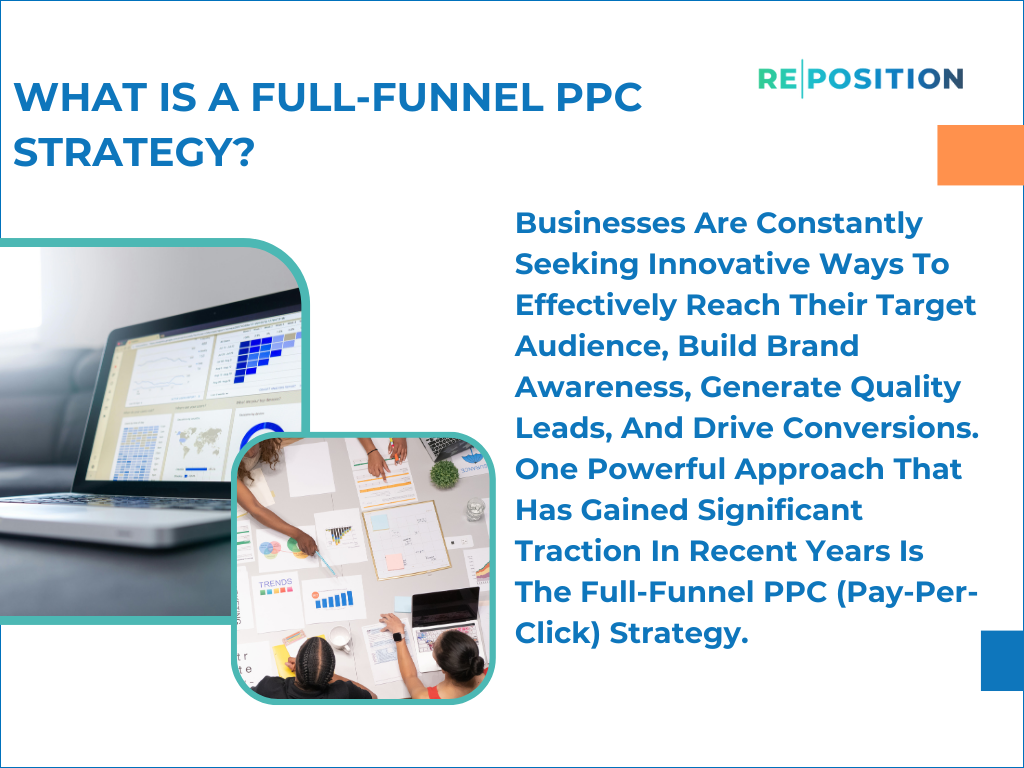
Concept Of The Sales Funnel – The Five Stages
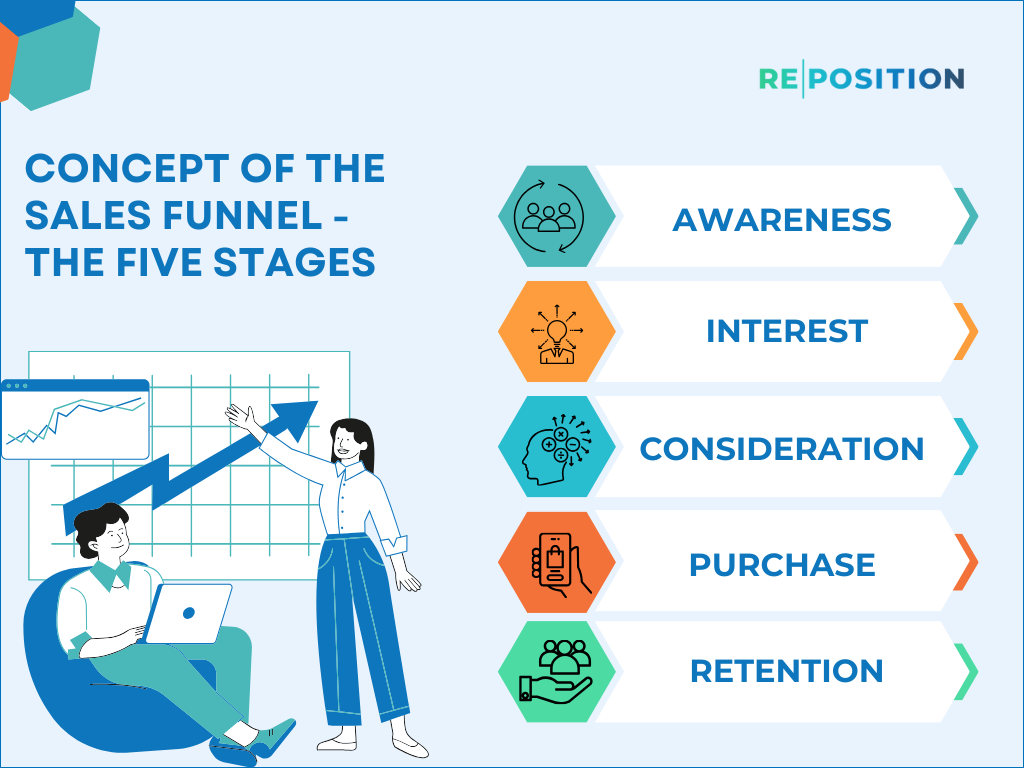
To fully comprehend the full-funnel PPC strategy, it’s essential to first understand the concept of the sales funnel. The sales funnel is a visual representation of the customer journey, which typically consists of several stages:
Awareness – At this initial stage, potential customers become aware of a product or service through various marketing efforts, such as advertising, social media, or word-of-mouth. The goal at this stage is to capture the attention of the target audience and introduce them to the brand and its offerings.
Interest – Once aware, potential customers develop an interest in the product or service and may start researching and gathering more information. They begin to explore the features, benefits, and unique selling points of the product or service, seeking to understand how it can address their needs or solve their problems.
Consideration – At this stage, potential customers evaluate different options, weigh the pros and cons, and compare the offerings from various providers. They engage in more in-depth research, read reviews, and analyse pricing and value propositions to narrow down their choices.
Purchase – If satisfied with their research and consideration, potential customers make a purchasing decision and complete the transaction. This stage represents the culmination of the customer’s journey, where they become a paying customer and engage with the business.
Retention – After the purchase, businesses aim to retain customers by providing exceptional service, fostering loyalty, and encouraging repeat business. This stage involves nurturing long-term relationships with customers, offering ongoing support, and providing incentives or special offers to drive repeat purchases and maximise customer lifetime value.
The Importance Of A Full-Funnel PPC Strategy
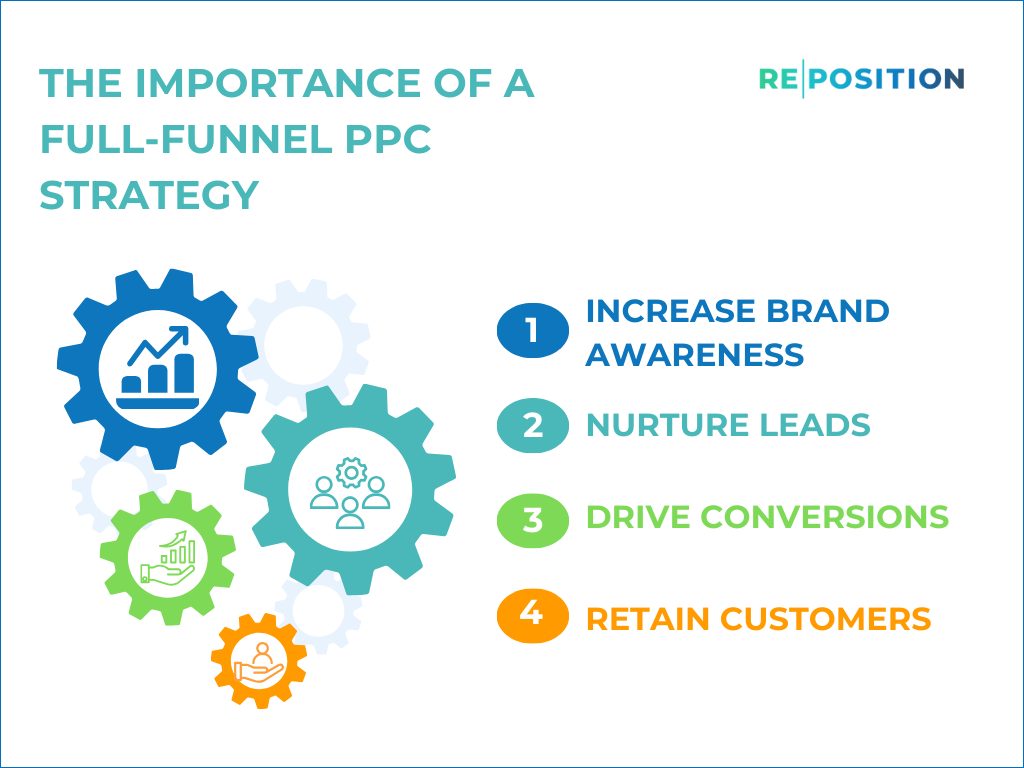
A full-funnel PPC strategy is crucial because it addresses the entirety of the customer journey, ensuring that businesses can effectively engage with potential customers at every stage. By leveraging PPC advertising across various channels, businesses can:
Increase Brand Awareness – Through targeted advertising on platforms like Google, social media, and display networks, businesses can introduce their brand and offerings to a wider audience, capturing their attention and generating initial interest. This helps to build brand recognition and establish a presence in the minds of potential customers.
Nurture Leads – By targeting specific keywords, demographics, and behaviours, businesses can serve relevant ads to potential customers who are actively researching and considering their options. This nurtures their interest and guides them further down the sales funnel, providing them with the information they need to make an informed decision.
Drive Conversions – With targeted ad campaigns focused on high-intent keywords and audiences, businesses can effectively convert prospects into paying customers by delivering persuasive messaging and compelling calls-to-action. These campaigns target individuals who are closer to making a purchase decision and are more likely to convert.
Retain Customers – By retargeting existing customers with relevant offers, promotions, and content, businesses can foster ongoing relationships, encourage repeat purchases, and ultimately maximise customer lifetime value. This helps to prevent customer churn and ensures that the business continues to provide value to its existing customer base.
Key Components Of A Full-Funnel PPC Strategy
To implement an effective full-funnel PPC strategy, businesses need to focus on several key components. Let us understand each component in more detail:
1st Key Component – Keywords
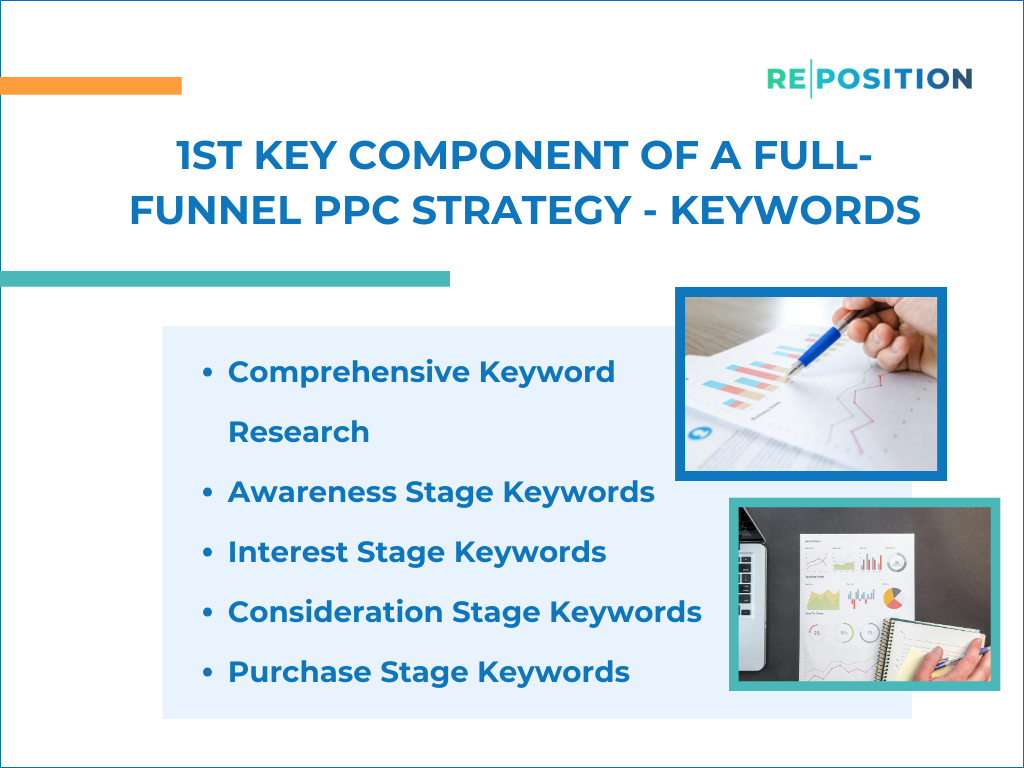
Comprehensive Keyword Research
Effective keyword research lays the foundation for a successful digital marketing strategy. This process involves identifying relevant search terms and phrases that potential customers use across various stages of the buyer’s journey. It commences with broad awareness keywords, progressing towards more specific, high-intent commercial keywords.
Initially, marketers should focus on uncovering general keywords related to the product or service offerings. These keywords often reflect the initial stages of the customer’s research process, indicating a broad interest or need. However, they do not necessarily signify a strong intent to make a purchase immediately.
As the research progresses, attention shifts towards discovering more specific, long-tail keywords. These phrases typically contain multiple words and convey a clearer understanding of the customer’s intent. Consequently, they tend to attract users who are further along in the decision-making process and actively seeking solutions.
Moreover, comprehensive keyword research encompasses identifying commercial keywords. These terms explicitly indicate a high likelihood of conversion, as they reflect a consumer’s readiness to make a purchase decision. Examples may include phrases like “buy [product]” or “[service] near me”.
By thoroughly researching and targeting keywords across the entire funnel, businesses can ensure that their messaging resonates with audiences at various stages of the buying cycle. Broad awareness keywords attract new prospects, while more specific terms cater to those actively seeking solutions. This approach maximises the potential for capturing leads and driving conversions.
Furthermore, the insights gained from keyword research inform the development of targeted ad campaigns. Aligning messaging with the user’s search intent at each stage enhances the relevance and effectiveness of marketing efforts. Ultimately, comprehensive keyword research lays the groundwork for a cohesive, data-driven digital marketing strategy that delivers the right message to the right audience at the right time.
Awareness Stage Keywords
In the early stages of the buyer’s journey, potential customers often search for broad, general terms to gain awareness and gather information about a particular product or service. These keywords, known as awareness-stage keywords, are typically less specific and do not convey a strong intent to make a purchase immediately. However, they play a crucial role in introducing potential customers to a brand and initiating the consideration process.
For instance, an individual interested in tracking their fitness activities might search for phrases like “best fitness trackers” or “wearable activity monitors”. These queries indicate a general awareness of fitness-tracking devices but do not necessarily signal purchase readiness. Similarly, a business seeking cloud storage solutions might initially search for terms such as “cloud storage services” or “online data storage”.
While awareness-stage keywords may not directly drive conversions, they are essential for attracting relevant traffic to a website or online presence. By targeting these keywords through content marketing, social media, and other awareness-building efforts, businesses can increase their visibility and establish themselves as credible sources of information within their respective industries.
Moreover, capturing the attention of potential customers at this stage allows brands to nurture these leads over time. As customers progress through the buyer’s journey, businesses can provide additional relevant content, resources, and targeted messaging to guide them towards a purchase decision.
Consequently, awareness-stage keywords should not be overlooked in a comprehensive keyword research strategy. Although they may not immediately translate into sales, they are essential for initiating the customer journey and building brand awareness, which ultimately contributes to long-term success and growth.
Interest Stage Keywords
As potential customers progress through the buyer’s journey, they begin to exhibit a more focused interest in specific products or services. At this stage, they utilise keywords that are more specific and targeted, signalling their active research and information-gathering process. These search terms are known as interest-stage keywords.
For example, an individual initially interested in fitness trackers may search for phrases like “(company name) review” or “Apple Watch Series 8 features”. These queries indicate a deeper level of interest in particular models or brands, as the customer seeks to evaluate their options and make an informed decision.
Similarly, a business exploring cloud storage solutions might search for terms such as “Dropbox pricing plans” or “Google Drive storage capacity”. These interest-stage keywords demonstrate a desire to understand the specific offerings, pricing structures, and capabilities of various cloud storage providers.
By targeting interest-stage keywords, businesses can effectively engage with potential customers who are actively researching and comparing different solutions. This presents an opportunity to provide detailed product information, comparisons, and customer testimonials to influence the decision-making process.
Additionally, interest-stage keywords can inform the creation of targeted content marketing strategies. By producing high-quality, informative content that directly addresses these specific search queries, businesses can position themselves as thought leaders and trusted sources of information within their respective industries.
Consequently, incorporating interest-stage keywords into a comprehensive keyword research strategy is crucial for capturing the attention of potential customers who are actively evaluating their options. By meeting their information needs at this critical stage, businesses can increase their chances of guiding these prospects towards a favourable purchase decision.
Consideration Stage Keywords
As potential customers progress further along the buyer’s journey, they enter the consideration stage, where they actively compare different options and weigh their alternatives. At this point, their search queries become more specific and focused, reflecting their intent to make an informed decision. These search terms are known as consideration-stage keywords.
For instance, an individual interested in purchasing a fitness tracker might search for phrases like “company vs. another company name” or “best smartwatch for runners”. These queries demonstrate a desire to evaluate the relative strengths and weaknesses of different brands or models, as well as their suitability for specific needs.
By targeting these keywords, businesses can provide valuable, objective information to assist potential customers in their decision-making process. This may include side-by-side product comparisons, detailed feature breakdowns, and unbiased reviews or case studies.
Moreover, consideration-stage keywords can inform the development of targeted remarketing campaigns and personalised messaging strategies. By understanding the specific concerns and considerations of potential customers at this stage, businesses can tailor their messaging and content to address these pain points effectively.
Purchase Stage Keywords
Towards the final stage of the buyer’s journey, potential customers exhibit a strong intent to make a purchase. Their search queries, known as purchase-stage keywords, are highly specific and often include transactional phrases or terms indicating a readiness to convert.
Examples of purchase-stage keywords may include “buy a smartwatch” or “sign up for Dropbox business plan”. These search terms leave little doubt about the user’s intent to acquire a particular product or service.
By targeting these high-intent keywords, businesses can ensure that their messaging and marketing efforts are focused on capturing customers who are ready to take action. This may involve optimising product pages, improving checkout processes, and providing compelling calls-to-action to facilitate conversions.
Additionally, purchase-stage keywords can inform the development of targeted advertising campaigns, such as remarketing efforts or product listing ads (PLAs), designed to reach customers at the critical moment when they are actively seeking to make a purchase.
Comprehensive keyword research that encompasses consideration-stage and purchase-stage keywords is essential for maximising the effectiveness of digital marketing efforts. By understanding and addressing the specific needs and interests of potential customers at each stage of the buyer’s journey, businesses can create a seamless and engaging experience that ultimately drives conversions and revenue growth.
2nd Key Component – Messaging
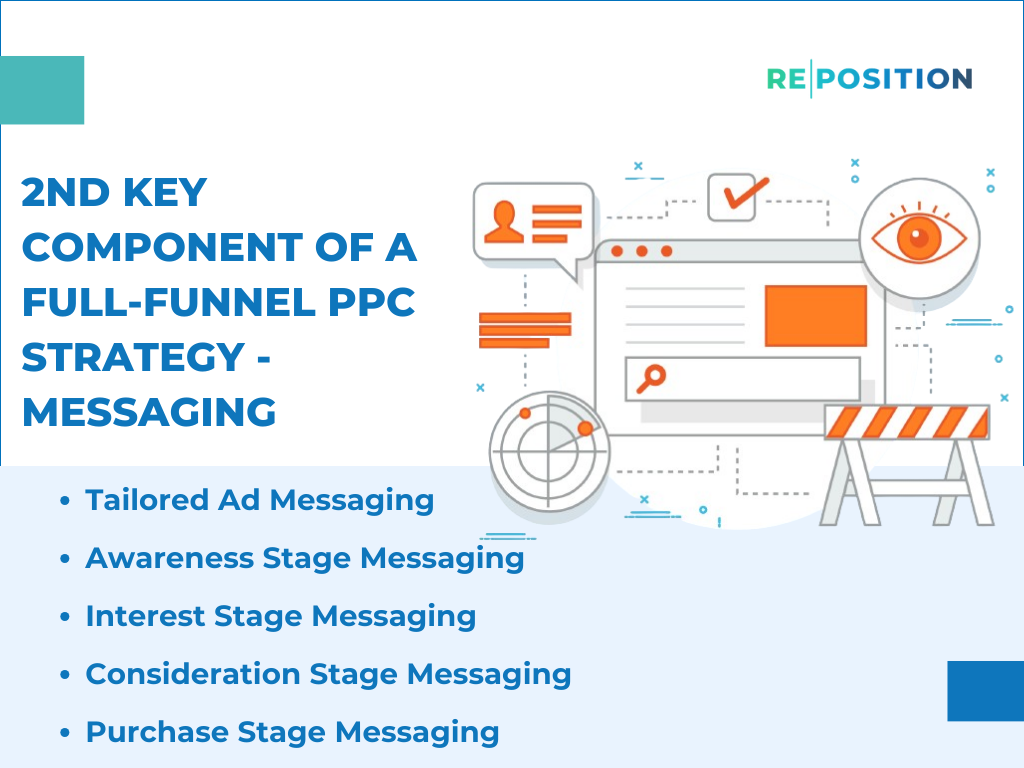
Tailored Ad Messaging
Crafting tailored ad messaging is crucial for ensuring that potential customers receive relevant and resonant information at each stage of the marketing funnel. This approach enhances the effectiveness of advertising campaigns and increases the likelihood of capturing and nurturing leads successfully.
For awareness-stage campaigns, ad messaging should primarily focus on introducing the brand and generating initial interest among the target audience. Advertisements at this stage should highlight the key benefits and unique value propositions of the product or service concisely and compellingly. The goal is to pique curiosity and encourage potential customers to explore further.
Conversely, consideration-stage ad messaging should provide more detailed information to nurture leads and address common objections or concerns. This type of messaging can include in-depth product features, comparisons with competitors, customer testimonials, and responses to frequently asked questions. By addressing these pain points and objections proactively, businesses can guide potential customers through the decision-making process more effectively.
Furthermore, purchase-stage ad messaging should be highly targeted and designed to drive conversions. This may involve highlighting limited-time offers, emphasising urgency or scarcity, and providing clear calls to action that facilitate the purchase process. Clarity and simplicity are essential at this stage to minimise potential barriers to conversion.
In addition to aligning ad messaging with the appropriate stage of the funnel, businesses should also consider tailoring their messaging to specific customer personas or segments. By understanding the unique needs, preferences, and pain points of different target audiences, marketers can craft messaging that resonates more deeply and effectively captures their attention.
Ultimately, tailored ad messaging is a critical component of a comprehensive digital marketing strategy. By delivering the right message to the right audience at the right time, businesses can enhance engagement, nurture leads more effectively, and ultimately drive higher conversion rates and return on investment.
Awareness Stage Messaging
In the initial stages of the marketing funnel, the primary objective is to introduce the brand and its core offerings to potential customers, generating curiosity and interest along the way. Awareness-stage messaging should therefore focus on highlighting the unique value propositions or key benefits that differentiate the product or service from competitors.
The messaging at this stage should be concise, engaging, and memorable, capturing the essence of what the brand represents and the problems it aims to solve. For instance, a fitness tracker company might emphasise the device’s ability to monitor various health metrics accurately, providing users with valuable insights into their overall well-being.
Moreover, awareness-stage messaging should strive to establish an emotional connection with the target audience. This can be achieved by leveraging storytelling techniques, relatable scenarios, or aspirational messaging that resonates with the audience’s values and desires.
It is crucial to strike a balance between piquing interest and avoiding overly promotional or sales language at this stage. The goal is to introduce the brand and its offerings in a way that sparks curiosity and motivates potential customers to explore further, without overwhelming them with excessive details or hard sales.
Furthermore, awareness-stage messaging should be tailored to the specific channels and platforms where the target audience is most likely to engage. This may involve crafting compelling social media posts, visually appealing display ads, or informative blog content that aligns with the brand’s messaging and resonates with the intended audience.
Ultimately, effective awareness-stage messaging lays the foundation for building brand recognition and establishing a strong presence in the market. By capturing the audience’s attention and generating interest, businesses can pave the way for nurturing leads and guiding them through the subsequent stages of the marketing funnel.
Interest Stage Messaging
As potential customers progress through the marketing funnel, their information needs become more specific and targeted. At the interest stage, messaging should shift towards providing in-depth information about specific features, benefits, and use cases to address the research and information-gathering needs of these prospects.
The goal of interest-stage messaging is to nurture leads by positioning the product or service as a viable solution to their pain points or challenges. This can be achieved by highlighting key features and their associated benefits clearly and compellingly. For example, a cloud storage provider might emphasise the security measures and data encryption capabilities of their platform, addressing concerns around data privacy and protection.
Additionally, interest-stage messaging should showcase real-world use cases and success stories to demonstrate the practical applications and value of the offering. Case studies, customer testimonials, and industry-specific examples can be powerful tools for illustrating how the product or service has solved similar challenges faced by others.
It is essential to strike a balance between providing comprehensive information and overwhelming potential customers with excessive details. The messaging should be structured in a way that allows prospects to easily navigate and access the information most relevant to their specific needs and interests.
Furthermore, interest-stage messaging should be tailored to the preferred channels and content formats of the target audience. This may involve creating detailed product guides, informative webinars, or in-depth blog posts that dive into the intricacies of the offering and its applications.
By delivering targeted, informative messaging at the interest stage, businesses can position themselves as subject matter experts and trusted advisors in their respective industries. This approach not only addresses the immediate information needs of potential customers but also builds credibility and trust, laying the foundation for future consideration and potential conversion.
Consideration Stage Messaging
At the consideration stage, potential customers have narrowed down their options and are actively evaluating different solutions to address their specific needs. Consequently, messaging during this phase should emphasise competitive advantages, address common objections or concerns, and highlight unique selling points to persuade these prospects to choose the offered product or service over competitors.
Businesses should leverage comparative analysis and side-by-side comparisons to highlight the distinct features, capabilities, or pricing models that differentiate their offerings from alternatives in the market. This approach helps to clearly articulate the value proposition and reinforce the reasons why the solution is superior to others.
Furthermore, consideration-stage messaging must proactively address common objections or concerns that potential customers may have. This could involve addressing issues related to cost, implementation challenges, or perceived limitations of the product or service. By directly acknowledging and addressing these pain points, businesses can demonstrate a deep understanding of their target audience’s needs and build trust.
In addition to addressing objections, consideration-stage messaging should emphasise unique selling points that set the offering apart from competitors. This could include highlighting proprietary technology, exceptional customer support, industry-leading expertise, or any other distinct advantages that provide a compelling reason for potential customers to choose the offered solution.
Notably, consideration-stage messaging should be tailored to specific customer segments or personas, ensuring that the language, tone, and emphasis align with the unique needs and preferences of each target audience. For instance, messaging targeted at small businesses may prioritise cost-effectiveness and ease of use, while messaging for enterprise customers may focus on scalability and advanced features.
Overall, effective consideration-stage messaging plays a crucial role in guiding potential customers through the decision-making process and ultimately influencing their choice in favour of the offered product or service. By addressing concerns, highlighting competitive advantages, and emphasising unique selling points, businesses can increase their chances of conversion and long-term customer loyalty.
Purchase Stage Messaging
At the purchase stage, potential customers have completed their research and are primed to make a buying decision. Consequently, messaging during this critical phase should focus on creating a sense of urgency and scarcity, emphasising limited-time offers, discounts, or promotions to encourage immediate action and conversion.
The primary objective of purchase-stage messaging is to remove any remaining barriers or hesitations that may be preventing the potential customer from completing the transaction. This can be achieved by highlighting the time-sensitive nature of special offers, discounts, or promotional pricing, creating a fear of missing out on a valuable opportunity.
For instance, messaging may emphasise phrases like “Limited time offer,” “Ends soon,” or “Only X days left” to instil a sense of urgency and prompt the potential customer to take action before the deal expires. Additionally, messaging can highlight scarcity by emphasising limited stock availability or the exclusivity of a particular offer.
However, it is essential to strike a balance between creating a sense of urgency and appearing overly aggressive or pushy in the messaging. The language should be persuasive yet respectful, focusing on the value proposition and the potential consequences of missing out on the opportunity.
Furthermore, purchase-stage messaging should be seamlessly integrated into the overall customer experience, appearing prominently on product pages, checkout processes, and targeted email campaigns or remarketing efforts. Clear and concise calls-to-action should guide the potential customer through the purchase journey, minimising friction and reducing the likelihood of abandoned carts or incomplete transactions.
Effective purchase-stage messaging plays a crucial role in converting interested prospects into paying customers. By leveraging urgency and scarcity tactics, businesses can create a compelling incentive for immediate action, capitalising on the potential customer’s interest and desire to acquire the product or service.
3rd Key Component – Targeting
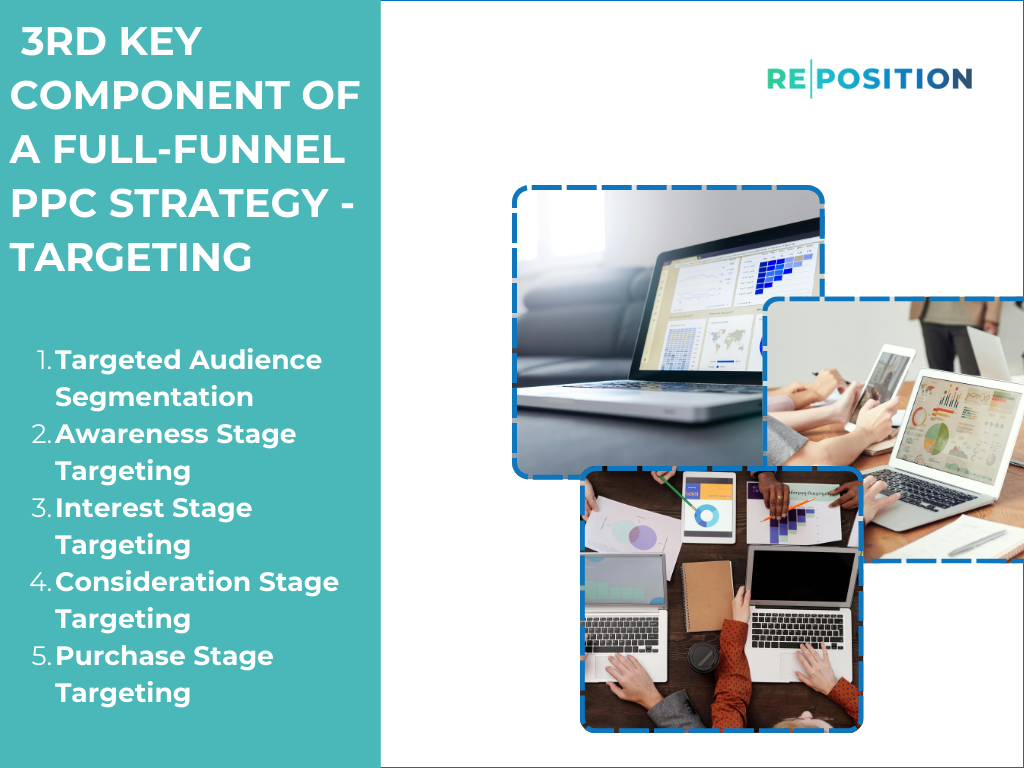
Targeted Audience Segmentation
Leverage audience targeting features offered by various PPC platforms to segment and target specific demographics, interests, and behaviours aligned with each stage of the funnel. This ensures that the right message reaches the right audience at the right time, maximising the effectiveness of the advertising efforts.
Awareness Stage Targeting
Target broad demographics, interests, and behaviours related to the product or service category. For example, if advertising fitness trackers, targets individuals interested in fitness, health, and wellness.
Interest Stage Targeting
Refine the audience targeting to focus on individuals who have shown specific interest or engagement with related content or products. For example, target individuals who have visited fitness tracker review websites or engaged with posts about fitness wearables on social media.
Consideration Stage Targeting
Further, refine the audience to target individuals who have actively researched and compared specific products or services. For example, target individuals who have searched for product comparisons or visited competitor websites.
Purchase Stage Targeting
Focus on highly qualified leads by targeting individuals who have demonstrated clear purchase intent, such as those who have added items to their online shopping cart or visited pricing pages.
4th Key Component – Advertising
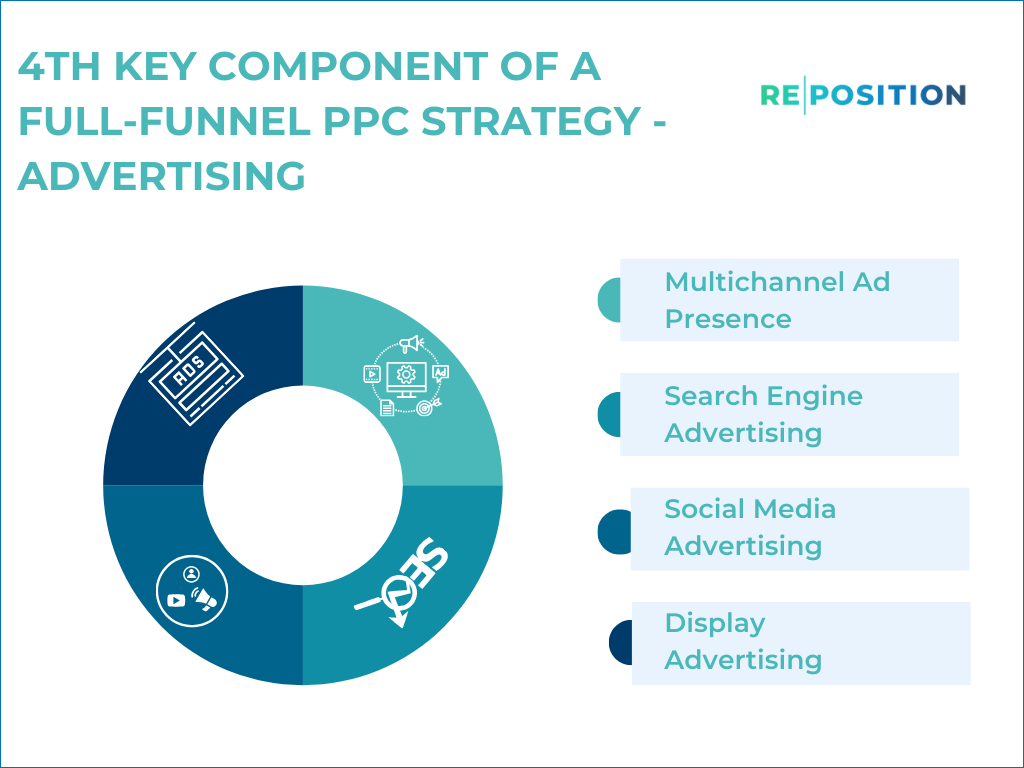
Multichannel Ad Presence
Expand the reach of PPC campaigns by advertising on multiple platforms, including search engines (e.g., Google Ads), social media (e.g., Facebook Ads, LinkedIn Ads), and display networks. This approach allows businesses to capture potential customers across different touchpoints, ensuring maximum visibility and increasing the chances of engaging with the target audience at various stages of their journey.
Search Engine Advertising
Utilise platforms like Google Ads to reach potential customers actively searching for products or services related to your business.
Social Media Advertising
Leverage social media platforms like Facebook, Instagram, and LinkedIn to target specific demographics, interests, and behaviours based on user profiles and activities.
Display Advertising
Utilise display networks to serve visually appealing ads on websites and apps that align with your target audience’s interests and browsing habits.
5th Key Component – Optimising Landing Pages
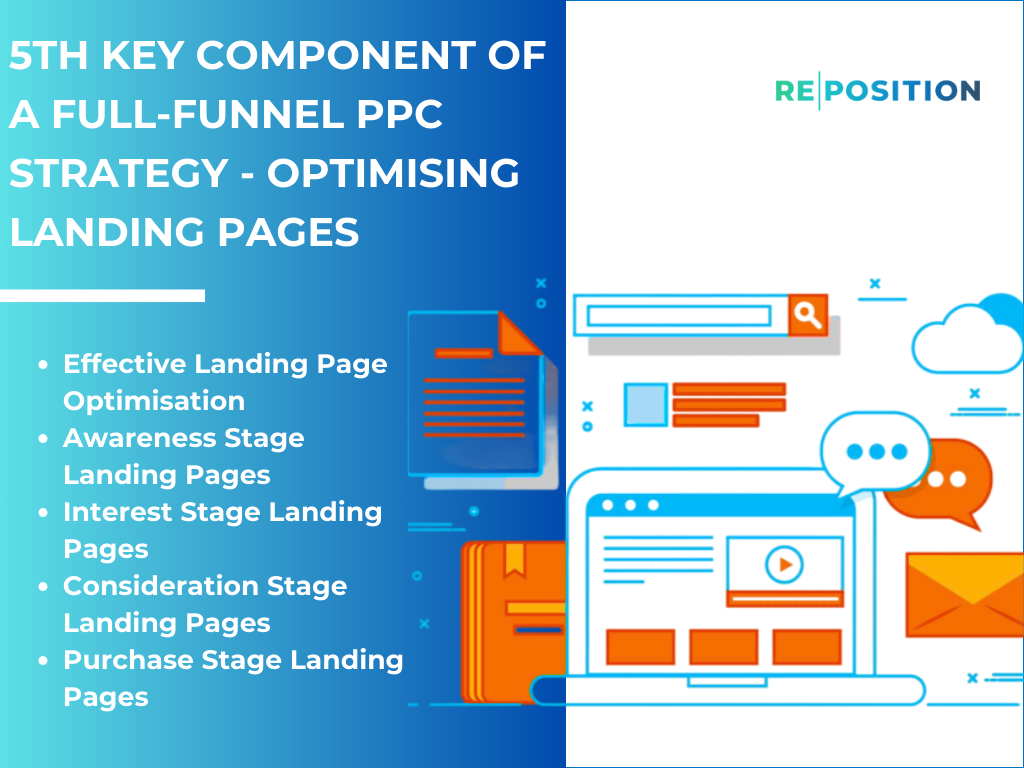
Effective Landing Page Optimisation
Optimise landing pages for each stage of the funnel, ensuring they align with the messaging and intent of the corresponding ad campaigns. Well-designed landing pages can significantly improve conversion rates and user experience by providing a seamless transition from the ad to the desired action, whether it’s making a purchase, signing up for a mailing list, or downloading a resource.
Awareness Stage Landing Pages
Focus on capturing lead information (e.g., email addresses) by offering valuable content, such as ebooks, whitepapers, or webinars, in exchange for contact details.
Interest Stage Landing Pages
Provide detailed information about specific products or services, including features, benefits, pricing, and testimonials, to help potential customers make informed decisions.
Consideration Stage Landing Pages
Highlight competitive advantages, address common objections or concerns, and offer more advanced resources like product demos, free trials, or detailed comparison guides to persuade potential customers to choose your offering.
Purchase Stage Landing Pages
Streamline the purchasing process by presenting a clear call-to-action, showcasing any limited-time offers or promotions, and minimising distractions that could deter conversions.
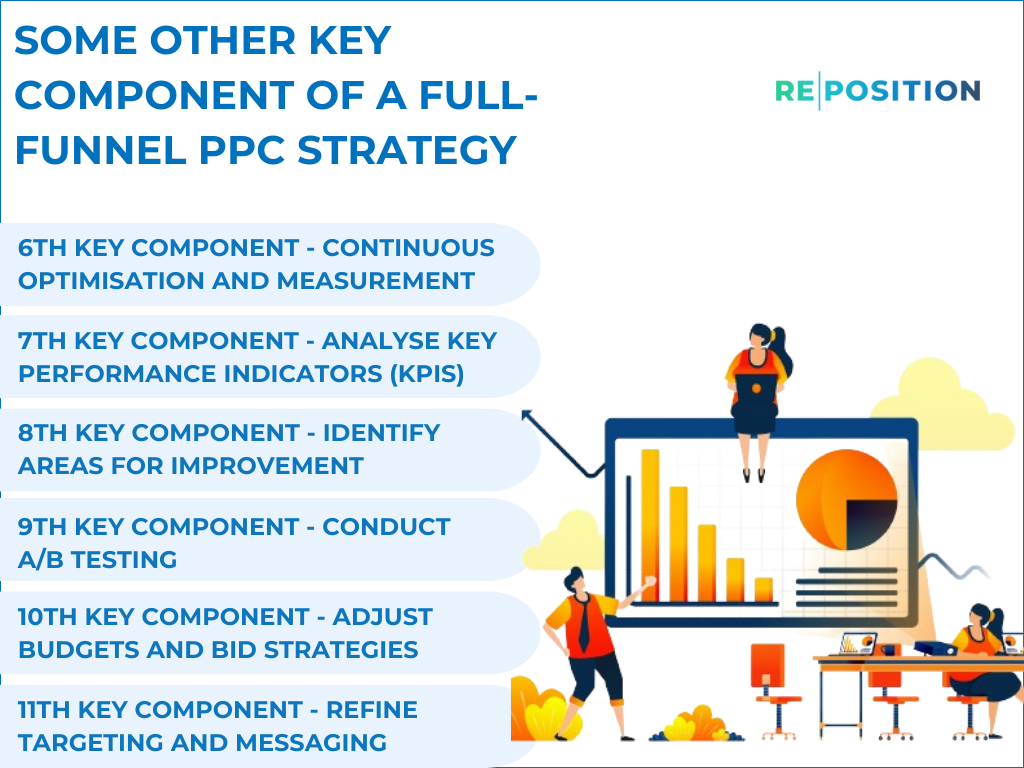
6th Key Component – Continuous Optimisation and Measurement
Regularly analyse campaign performance data, user behaviour, and conversion metrics to identify areas for improvement. Continuously optimise ad targeting, messaging, and landing pages based on this data, and make informed decisions to refine the overall strategy. By continuously monitoring and optimising the full-funnel PPC strategy, businesses can maximise their return on investment and ensure that their advertising efforts remain effective and efficient.
7th Key Component – Analyse Key performance indicators (KPIs)
Track and analyse metrics such as click-through rates (CTR), conversion rates, cost per acquisition (CPA), and return on ad spend (ROAS) to understand the effectiveness of your campaigns at each stage of the funnel.
8th Key Component – Identify Areas For Improvement
Look for patterns or trends in the data that may indicate areas where optimisation is needed. For example, if a particular ad or landing page has a low CTR or conversion rate, it may need to be modified or replaced.
9th Key Component – Conduct A/B Testing
Use A/B testing to compare different versions of ads, landing pages, or other elements to determine which variations perform better and make data-driven decisions about which changes to implement.
10th Key Component – Adjust Budgets And Bid Strategies
Based on performance data, adjust budgets and bid strategies to allocate more resources to the campaigns or channels that are delivering the best results, while reducing spend on underperforming areas.
11th Key Component – Refine Targeting And Messaging
Continuously refine audience targeting and ad messaging based on insights gained from analysing the data, ensuring that you are reaching the right people with the right message at the right time.
Benefits Of A Full-Funnel PPC Strategy
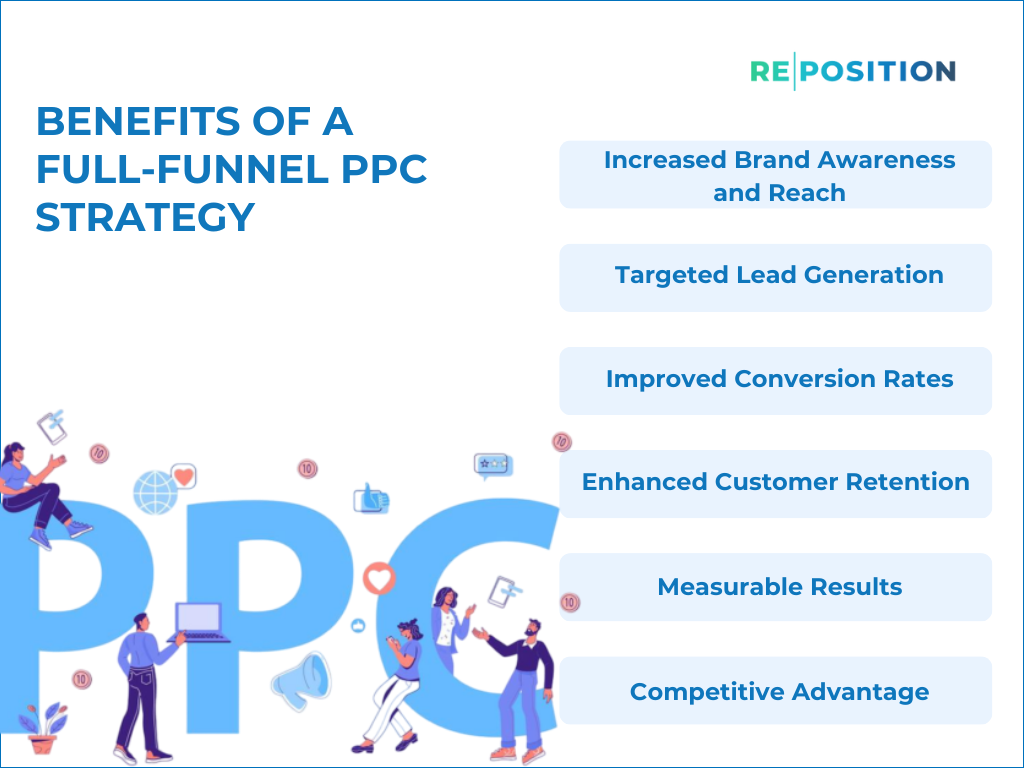
Implementing a full-funnel PPC strategy offers numerous benefits to businesses, including
Increased Brand Awareness and Reach – By targeting a wide range of keywords and audiences across various platforms, businesses can significantly increase their brand’s visibility and reach a larger pool of potential customers. This helps to establish a strong brand presence and ensures that the business remains top-of-mind for its target audience.
Targeted Lead Generation – Tailored messaging and audience targeting at each stage of the funnel enable businesses to generate high-quality leads that are more likely to convert, resulting in a higher return on investment (ROI) for their PPC campaigns. By delivering the right message to the right audience at the right time, businesses can attract and nurture leads who are genuinely interested in their offerings.
Improved Conversion Rates – By serving relevant ads and optimised landing pages to audiences with high purchase intent, businesses can improve their overall conversion rates and maximise the effectiveness of their PPC budget. By addressing the specific needs and concerns of potential customers at each stage of the funnel, businesses can increase the likelihood of converting leads into paying customers.
Enhanced Customer Retention – Retargeting campaigns focused on existing customers can help foster long-term relationships, encourage repeat purchases, and ultimately increase customer lifetime value, leading to sustainable business growth. By providing ongoing value and addressing the evolving needs of their customer base, businesses can reduce customer churn and maintain a loyal following.
Measurable Results – PPC campaigns provide detailed data and analytics, allowing businesses to measure their performance, track conversions, and make data-driven decisions to continuously optimise their strategies. This level of transparency and measurability enables businesses to determine the return on investment (ROI) of their advertising efforts and make informed decisions about resource allocation and budget optimisation.
Competitive Advantage – By implementing a comprehensive full-funnel PPC strategy, businesses can gain a significant competitive edge over their rivals who may not be leveraging the full potential of PPC advertising across the entire customer journey. This strategic approach can help businesses stand out in a crowded market and capture a larger share of the target audience.
Conclusion
A full-funnel PPC strategy is essential for businesses to effectively reach, engage, and convert potential customers at every stage of the sales funnel. By leveraging the power of targeted advertising across various platforms and channels, businesses can increase brand awareness, nurture leads, drive conversions, and foster customer retention.
Implementing a successful full-funnel PPC strategy requires comprehensive keyword research, tailored ad messaging, targeted audience segmentation, a multichannel ad presence, optimised landing pages, and continuous optimisation based on data and performance metrics. By investing in this comprehensive approach, businesses can maximise their PPC ROI, gain a competitive edge, and ultimately drive sustainable growth and success.
As the digital marketing industry continues to evolve, businesses that embrace a full-funnel PPC strategy and stay agile in their approach will be better positioned to adapt to changing customer behaviours and emerging trends, ensuring they remain relevant and competitive in this digital arena.
 Organic
Organic  Digital Advertising
Digital Advertising  Resources
Resources  Content Marketing
Content Marketing  Resources
Resources  Who We Are
Who We Are 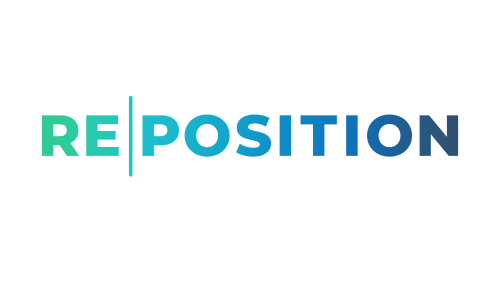
 Social
Social  Request a Quote
Request a Quote Pricing Guides
Pricing Guides 
 London
London










